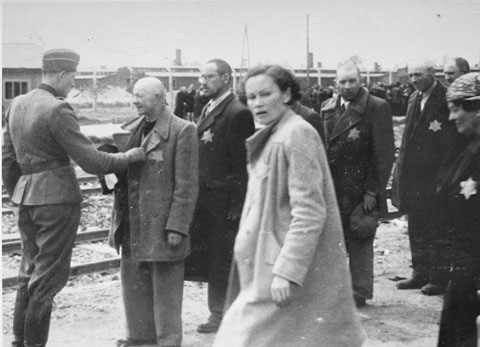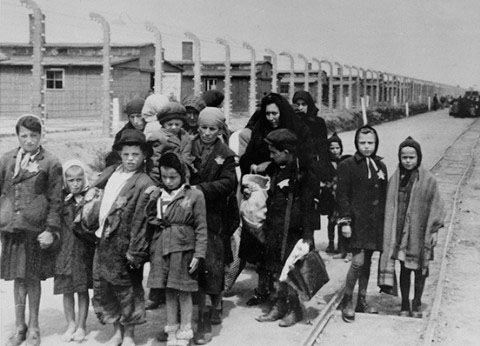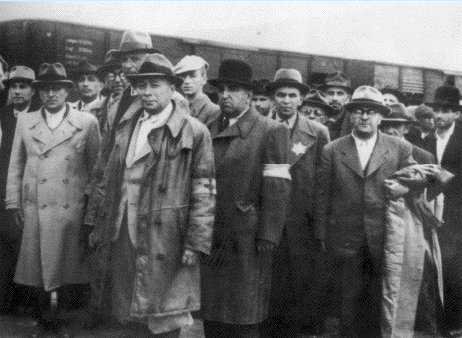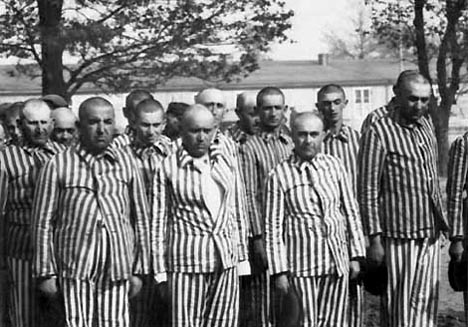The Deportation of the Hungarian
Jews

The woman in the foreground
is Geza Lajtbs from Budapest
The photo above, taken at Auschwitz on
May 26, 1944, shows the selection process which took place immediately
after the Hungarian Jews got off the train inside the Birkenau
camp. The men and women had to line up in two separate lines
to be examined by an SS officer who decided who would live and
who would be sent immediately to the gas chamber. Note the yellow
stars which the Hungarian Jews had been forced to wear on their
coats.

Two transport trains
inside the Birkenau camp, May 1944
The photo above shows two trains inside
the Birkenau camp. At the end of the tracks on the right side
is Crematorium No. 3, called Krema III, where Jews were killed
in a gas chamber. The train on the left has brought Jews up to
the Krema II gas chamber on the left side of the tracks at the
western end of the camp.
The Auschwitz II camp, also known as
Birkenau, had enough barracks to accommodate 200,000 prisoners
and another section, called Mexico by the prisoners, was under
construction. When finished, the new section would have provided
housing for 50,000 more prisoners.
According to Daniel Goldhagen, the author
of the best-selling book entitled "Hitler's Willing Executioners,"
the Nazis were in a frenzy to complete the genocide of the Jews
before the end of the war. Even though they were desperate for
workers in their munitions factories, it was more important to
the Nazis to carry out the Final Solution to the Jewish Question,
according to Goldhagen who wrote the following:
Finally, the fidelity of the Germans
to their genocidal enterprise was so great as seeming to defy
comprehension. Their world was disintegrating around them, yet
they persisted in genocidal killing until the end.
Pictured in the photo below are members
of the Pinkas and Gutmann families from Maramaros. Golda Pinkas
Berkovics is pictured at the bottom right; Moshe Leib Pinkas
is the child in the foreground. Behind him is Sheindele Pinkas.
On the bottom left is Rivka Gutmann holding her daughter. They
are waiting for their turn in the gas chambers at Birkenau, according
to the Yad Vashem Museum which has the original of this photo
from the Auschwitz Album.
 Moshe Leib Pinkas is
the child in the center
Moshe Leib Pinkas is
the child in the center
In June 1944, Adolf Eichmann deported
20,000 Hungarian Jews to Auschwitz and then transferred them
to the Strasshof labor camp near Vienna. This was an attempt
to extort money from the Jewish community in Hungary, according
to Laurence Rees who wrote in his book "Auschwitz, a New
History," that Eichmann convinced the Jewish leaders that
he was going against orders in making an exception for these
Jews and then demanded money for food and medical care because
he had saved 20,000 Jews from the gas chambers at Auschwitz.
David Cesarani wrote in "The Last Days," that Jewish
leader Rudolf Kastner was able to prod Eichmann into sending
these Jews to Austria where three quarters of them survived the
war.
The last mass transport of 14,491 Hungarian
Jews to Auschwitz arrived on July 9, 1944, according to a book
entitled "Die Zahl der Opfer von Auschwitz," by Franciszek
Piper, the director of the Auschwitz Museum. After this mass
transport of Jews left Hungary on July 8, 1944, Horthy ordered
the deportation of the Hungarian Jews to stop.
By that time, a minimum of 435,000 Hungarian
Jews, mostly those living in the villages and small towns, had
been transported to Auschwitz, according to evidence given at
the trial of Adolf Eichmann in Jerusalem in 1961 in which transportation
lists compiled by Laszlo Ferenczy, the chief of police in Hungary,
were introduced.
 Hungarian Jews walk
toward the gas chambers in Krema IV and Krema V
Hungarian Jews walk
toward the gas chambers in Krema IV and Krema V
On July 14, 1944, Adolf Eichmann attempted
to deport another 1,500 Jews, but Horthy ordered the train to
turn around before it could make it past the Hungarian border.
On July 19th, Eichmann ordered the 1,500 Jews to be loaded onto
the train again and rushed out of the country.
On August 13, 1944, a small transport
of 131 Jews arrived from Hungary at Auschwitz and on August 18,
1944, the last transport of 152 Jews arrived.
In a telegram sent to the Foreign Office
in Berlin on July 11, 1944 by Edmund Veesenmayer, it was reported
that 55,741 Jews had been deported from Zone V by July 9th, as
planned, and that the total number of Jews deported from Zones
I through V in Hungary was 437,402
In a book entitled "The World Must
Know," which is the official book for the US Holocaust Memorial
Museum, Michael Birnbaum wrote:
Between May 14 and July 8, 1944, 437,402
Jews from fifty-five Hungarian localities were deported to Auschwitz
in 147 trains. Most were gassed at Birkenau soon after they arrived.
The railroad system was stretched to its limits to keep up with
the demand of the camp, where as many as 12,000 people a day
were being gassed.
Robert E. Conot wrote in his book "Justice
at Nuremberg" that 330,000 of the Hungarian Jews were sent
directly to the gas chambers at Auschwitz. The Encyclopedia of
the Holocaust puts the total number of Hungarian Jews who died
at Auschwitz-Birkenau between May and July 1944 at approximately
550,000, the majority of whom were gassed. Raul Hilberg stated
in his book entitled "The Destruction of the European Jews"
that over 180,000 Hungarian Jews died at Auschwitz-Birkenau.
According to Francizek Piper, the majority
of the Hungarian Jews, who were sent to Auschwitz-Birkenau, were
gassed immediately. A booklet purchased from the Auschwitz Museum
stated that 434,351 of the Hungarian Jews were gassed upon arrival.
If these figures are correct, only 3,051 Hungarian Jews, out
of the 437,402 who were sent to Auschwitz, were registered in
the camp. However, Francizek Piper wrote that 28,000 Hungarian
Jews were registered.
 Hungarian men including
two doctors with arm bands
Hungarian men including
two doctors with arm bands
 Some of the same men
after a shower and a change of clothes
Some of the same men
after a shower and a change of clothes
The web site of the United States Holocaust
Memorial Museum confirms that over 100,000 Hungarian Jews were
used for labor, as agreed upon by Hitler and Horthy on March
18, 1944, and that some of them were transferred to other camps
within weeks of their arrival.
The following quote is from the USHMM
web site:
Between late April and early July
1944, approximately 440,000 Hungarian Jews were deported, around
426,000 of them to Auschwitz. The SS sent approximately 320,000
of them directly to the gas chambers in Auschwitz-Birkenau and
deployed approximately 110,000 at forced labor in the Auschwitz
concentration camp complex. The SS authorities transferred many
of these Hungarian Jewish forced laborers within weeks of their
arrival in Auschwitz to other concentration camps in Germany
and Austria.
If only 28,000 Hungarian Jews were registered
at Auschwitz-Birkenau, as stated by Franciszek Piper, the director
of the Auschwitz Museum, this means that thousands were transferred
from Auschwitz to labor camps without being registered.
According to records kept by the Germans
at the Dachau concentration camp, between June 18, 1944 and March
9, 1945, a total of 28,838 Hungarian Jews were sent from Auschwitz-Birkenau
to Dachau and then transferred to Landsberg am Lech to work on
construction of underground factories in the eleven Kaufering
subcamps of Dachau.
Nerin E. Gun was a Turkish journalist
who was imprisoned at Dachau in 1944; his job was to take down
the names and vital information from Hungarian Jewish women who
were on their way to be gassed in the fake shower room in the
Dachau crematorium.
In his book entitled "The Day of
the Americans," published in 1966, Gun wrote the following
regarding his work at Dachau:
I belonged to the team of prisoners
in charge of sorting the pitiful herds of Hungarian Jewesses
who were being directed to the gas chambers. My role was an insignificant
one: I asked questions in Hungarian and entered the answers in
German in a huge ledger. The administration of the camp was meticulous.
It wanted a record of the name, address, weight, age, profession,
school certificates, and so on, of all these women who in a few
minutes were to be turned into corpses. I was not allowed in
the crematorium, but I knew from the others what went on in there.
Some of the Jews who were selected for
slave labor were sent to the Mauthausen concentration camp in
Austria and its subcamps where they worked in German aircraft
factories.
Others were sent to the Stutthof camp
near Danzig, according to Martin Gilbert, who wrote the following
in his book entitled "Holocaust":
On June 17 Veesenmayer telegraphed
to Berlin that 340,142 Hungarian Jews had now been deported.
A few were relatively fortunate to be selected for the barracks,
or even moved out altogether to factories and camps in Germany.
On June 19 some 500 Jews, and on June 22 a thousand, were sent
to work in factories in the Munich area. [...] Ten days later,
the first Jews, 2500 women, were deported from Birkenau to Stutthof
concentration camp. From Stutthof, they were sent to several
hundred factories in the Baltic region. But most Jews sent to
Birkenau continued to be gassed.
According to the Museum at the former
Theresienstadt ghetto in what is now the Czech Republic, there
were 1,150 Hungarian Jews sent to Theresienstadt and 1,138 of
them were still there on May 9, 1945. Other prominent Jews that
were sent to Theresienstadt were transferred to Auschwitz in
October 1944, including the famous psychiatrist Victor Frankl
from Austria, who was not registered in Auschwitz, but was transferred
again, after three days in the Birkenau camp, to Dachau and then
sent to the Kaufering III sub-camp.
The Jews who were neither gassed nor
registered at Auschwitz upon arrival, but instead were transferred
to a labor camp, were called Durchgangsjuden because they were
held in a transit camp in the Mexico section of the Birkenau
camp for a short time.
This page was last updated on June 25,
2008
|